Attractions · Eastern Europe · Europe · Going Out · Regions · Russia
8 essential Russian Revolution sights in St Petersburg
Next month is the centenary of the Russian Revolution, an event that continues to shape the world we live in today. At that time the St Petersburg of today was named Petrograd and was the capital of Imperial Russia. Visit these key sights in St Petersburg today to travel in the footsteps of the Russian Revolution.
The Museum of Political History
The building that houses the museum was originally the mansion of Mathilde Kschessinska the prima ballerina at the Mariinsky Theatre before the Revolution and lover of Tsar Nicholas II (there has been much debate and controversy in Russia about the release of a film about her life and relationship with the last Tsar). In 1917, the building was seized by the Bolsheviks and turned into their headquarters in the city. It became the centre of their revolutionary activities, and Lenin made a historic speech from one of the balconies of the mansion after his arrival in the city. Today you can visit the room he worked from and see the entire collection that details Russian Politics from period of Catherine the Great to the end of the Cold War.
 Winter Palace
The Winter Palace was the hub of the Russian imperial court, the building a baroque extravaganza that dominates the riverfront. Catherine the Great started building her art collection in 1764, and over the next twenty years she kept acquiring other collections and expanded her own private museum. These collections were housed in a new building, attached to the Winter Palace. She named this new palace her Hermitage – meaning her sanctuary and haven.
Today the entire museum complex of six buildings is called the Hermitage.
There is no doubt that the Winter Palace is the architectural jewel in the crown of the entire museum. The unmistakable exterior, the imperial state rooms, the Jordan staircase and the gallery of the Napoleonic Wars. The Large Throne Room is almost 9,000 square feet in size!
Emperor Nicholas II and the Imperial family did not live in the Winter Palace, preferring the more modest Alexander Palace outside the city. After his abdication, the palace was the initial home of the provisional government. All members of the government were arrested in the palace on November 7 1917, when the Bolsheviks stormed the building thus putting the palace centre stage in the revolution. The Bolsheviks were furious to see such opulence and wealth, and some wanted to destroy the building. It was saved due to the magnificent art collection that was considered a national treasure. After the revolution, the entire complex of palaces facing the Neva River became a museum under the collective name the State Hermitage Museum which was open to the general public for the very first time showing the Romanov collection, and the confiscated art from Russian aristocratic families.
Winter Palace
The Winter Palace was the hub of the Russian imperial court, the building a baroque extravaganza that dominates the riverfront. Catherine the Great started building her art collection in 1764, and over the next twenty years she kept acquiring other collections and expanded her own private museum. These collections were housed in a new building, attached to the Winter Palace. She named this new palace her Hermitage – meaning her sanctuary and haven.
Today the entire museum complex of six buildings is called the Hermitage.
There is no doubt that the Winter Palace is the architectural jewel in the crown of the entire museum. The unmistakable exterior, the imperial state rooms, the Jordan staircase and the gallery of the Napoleonic Wars. The Large Throne Room is almost 9,000 square feet in size!
Emperor Nicholas II and the Imperial family did not live in the Winter Palace, preferring the more modest Alexander Palace outside the city. After his abdication, the palace was the initial home of the provisional government. All members of the government were arrested in the palace on November 7 1917, when the Bolsheviks stormed the building thus putting the palace centre stage in the revolution. The Bolsheviks were furious to see such opulence and wealth, and some wanted to destroy the building. It was saved due to the magnificent art collection that was considered a national treasure. After the revolution, the entire complex of palaces facing the Neva River became a museum under the collective name the State Hermitage Museum which was open to the general public for the very first time showing the Romanov collection, and the confiscated art from Russian aristocratic families.
 Alexander Palace and Park
Alexander Palace was built to the order of Catherine the Great for her grandson Alexander Pavlovich (later Alexander I), it was designed by Quarenghi in the classical style, and by tradition it was lived in by the Heir Apparent, (Nicholas I, Alexander II and III all lived here before becoming Tsar). Nicholas II and the last imperial family chose to make the Alexander Palace their main home, not the grand Winter Palace in the centre of the city.
In the weeks after the Imperial Family had left, it was already a museum, left exactly as it was on August 14, 1917. There was a huge demand to visit the palace. In 1934 more than half a million Soviet tourists visited the palace. During WWII the Palace was looted by the invading Germans and their Spanish allies (many of the treasures are still in German and Spanish museums), the palace was less damaged than the majority of Imperial palaces. What finished off the Alexander Palace was pilfering, the sale and removal of its contents, state vandalism (Stalin ordered the destruction of many of the rooms in which Nicholas and Alexandra had lived), and ultimately deliberate neglect – for a while it was a holiday home for the NKVD (secret police), part of the palace was still used as offices, by the Baltic Fleet for many years. Today, the palace is closed, and has been for several years. The plan being to restore it to its former glory. It is due to reopen in July 2018, to mark the 100th anniversary of the death of the last imperial family.
Alexander Palace and Park
Alexander Palace was built to the order of Catherine the Great for her grandson Alexander Pavlovich (later Alexander I), it was designed by Quarenghi in the classical style, and by tradition it was lived in by the Heir Apparent, (Nicholas I, Alexander II and III all lived here before becoming Tsar). Nicholas II and the last imperial family chose to make the Alexander Palace their main home, not the grand Winter Palace in the centre of the city.
In the weeks after the Imperial Family had left, it was already a museum, left exactly as it was on August 14, 1917. There was a huge demand to visit the palace. In 1934 more than half a million Soviet tourists visited the palace. During WWII the Palace was looted by the invading Germans and their Spanish allies (many of the treasures are still in German and Spanish museums), the palace was less damaged than the majority of Imperial palaces. What finished off the Alexander Palace was pilfering, the sale and removal of its contents, state vandalism (Stalin ordered the destruction of many of the rooms in which Nicholas and Alexandra had lived), and ultimately deliberate neglect – for a while it was a holiday home for the NKVD (secret police), part of the palace was still used as offices, by the Baltic Fleet for many years. Today, the palace is closed, and has been for several years. The plan being to restore it to its former glory. It is due to reopen in July 2018, to mark the 100th anniversary of the death of the last imperial family.
 Battleship Aurora
A floating piece of Russian history, the battleship Aurora was constructed in 1897 and served in the Russo-Japanese war, World War I, The October Revolution, and World War II. A blank shot from the canons of Aurora marked the beginning of the October Revolution, and for the last 70 years the ship has been moored in St Petersburg as a museum. In 2014, the Russian Navy had the ship renovated at the cost of $13Million. It returned to its mooring in St Petersburg after two years and has been as popular as ever with Russian and international visitors ever since.
Battleship Aurora
A floating piece of Russian history, the battleship Aurora was constructed in 1897 and served in the Russo-Japanese war, World War I, The October Revolution, and World War II. A blank shot from the canons of Aurora marked the beginning of the October Revolution, and for the last 70 years the ship has been moored in St Petersburg as a museum. In 2014, the Russian Navy had the ship renovated at the cost of $13Million. It returned to its mooring in St Petersburg after two years and has been as popular as ever with Russian and international visitors ever since.
 The Tauride Palace
With some disastrous losses at the front in World War I, and political unrest on the streets,Tsar Nicholas II resigned when he lost support of the army. The Tauride Palace became home to the interim provisional government between the February and October Revolutions. Since the end of the Soviet Union, this magnificent palace, commissioned by Grigory Potemkin to impress Catherine the Great, has been used as the home of the Commonwealth of Independent States (CIS) – former Soviet Republics. It was closed to the public for many years. Today constitutional assemblies are still held here, and it is possible to pre-book a private tour, with a minimum of one months’ notice.
The Tauride Palace
With some disastrous losses at the front in World War I, and political unrest on the streets,Tsar Nicholas II resigned when he lost support of the army. The Tauride Palace became home to the interim provisional government between the February and October Revolutions. Since the end of the Soviet Union, this magnificent palace, commissioned by Grigory Potemkin to impress Catherine the Great, has been used as the home of the Commonwealth of Independent States (CIS) – former Soviet Republics. It was closed to the public for many years. Today constitutional assemblies are still held here, and it is possible to pre-book a private tour, with a minimum of one months’ notice.
 Yusupov Palace
With World War I raging, and Tsar Nicholas away from St Petersburg much of the time, Alexandra, was wielding more and more influence on state affairs. Her close advisor was the monk, Grigory Rasputin. Many thought that the influence of Rasputin had to be stopped, including Prince Yusupov of the very wealthy aristocratic Yusupov family. The Yusupov Palace is worth visiting for many reasons – it’s private theatre, Arabian room and library, but it is most famous as the site of the poisoning and eventual murder of Grigory Rasputin.
Yusupov Palace
With World War I raging, and Tsar Nicholas away from St Petersburg much of the time, Alexandra, was wielding more and more influence on state affairs. Her close advisor was the monk, Grigory Rasputin. Many thought that the influence of Rasputin had to be stopped, including Prince Yusupov of the very wealthy aristocratic Yusupov family. The Yusupov Palace is worth visiting for many reasons – it’s private theatre, Arabian room and library, but it is most famous as the site of the poisoning and eventual murder of Grigory Rasputin.
 Smolny Institute
The Smolny Institute was formerly a school for girls. The Bolsheviks commandeered the building and made it the headquarters of the government until March 1918 when the capital was moved back to Moscow from St Petersburg. This was the nucleus of Bolshevik activity and rule, and where Lenin proclaimed Soviet power. Today you can book a tour to visit historical parts of the building, including Lenin’s office and the assembly hall.
Smolny Institute
The Smolny Institute was formerly a school for girls. The Bolsheviks commandeered the building and made it the headquarters of the government until March 1918 when the capital was moved back to Moscow from St Petersburg. This was the nucleus of Bolshevik activity and rule, and where Lenin proclaimed Soviet power. Today you can book a tour to visit historical parts of the building, including Lenin’s office and the assembly hall.
 Peter & Paul Cathedral & Prison
The golden spire of the Peter & Paul Cathedral is the symbol of the city of St Petersburg, being one of the original buildings to survive from the founding of the city in 1703. Every single Romanov Tsar is buried here. Now Nicholas, Alexandra and the entire last Imperial family is also buried here, and this is the best place to come with a guide to learn about the entire Romanov dynasty through their family tree. The cathedral is within the Peter & Paul Fortress that ironically also housed a prison used by the imperial family to imprison political prisoners. Later, the Bolsheviks would use the prison for the same purpose.
Peter & Paul Cathedral & Prison
The golden spire of the Peter & Paul Cathedral is the symbol of the city of St Petersburg, being one of the original buildings to survive from the founding of the city in 1703. Every single Romanov Tsar is buried here. Now Nicholas, Alexandra and the entire last Imperial family is also buried here, and this is the best place to come with a guide to learn about the entire Romanov dynasty through their family tree. The cathedral is within the Peter & Paul Fortress that ironically also housed a prison used by the imperial family to imprison political prisoners. Later, the Bolsheviks would use the prison for the same purpose.
 A visit to St Petersburg will bring history that changed the world to life. For a real-time in-depth look at the events leading up to the Revolution, this website is fantastic detailing the series of events that took place 100 years ago, by people that were there.
Ala Osmond is Director at Exeter International.
If you would like to be a guest blogger on A Luxury Travel Blog in order to raise your profile, please contact us.
A visit to St Petersburg will bring history that changed the world to life. For a real-time in-depth look at the events leading up to the Revolution, this website is fantastic detailing the series of events that took place 100 years ago, by people that were there.
Ala Osmond is Director at Exeter International.
If you would like to be a guest blogger on A Luxury Travel Blog in order to raise your profile, please contact us.
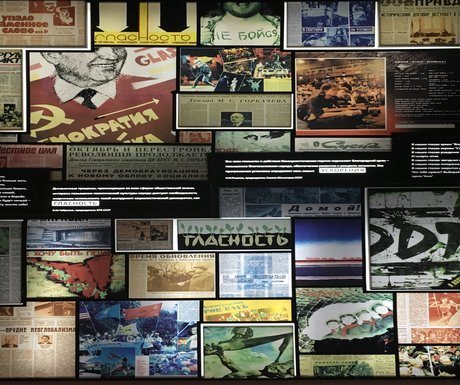 Winter Palace
The Winter Palace was the hub of the Russian imperial court, the building a baroque extravaganza that dominates the riverfront. Catherine the Great started building her art collection in 1764, and over the next twenty years she kept acquiring other collections and expanded her own private museum. These collections were housed in a new building, attached to the Winter Palace. She named this new palace her Hermitage – meaning her sanctuary and haven.
Today the entire museum complex of six buildings is called the Hermitage.
There is no doubt that the Winter Palace is the architectural jewel in the crown of the entire museum. The unmistakable exterior, the imperial state rooms, the Jordan staircase and the gallery of the Napoleonic Wars. The Large Throne Room is almost 9,000 square feet in size!
Emperor Nicholas II and the Imperial family did not live in the Winter Palace, preferring the more modest Alexander Palace outside the city. After his abdication, the palace was the initial home of the provisional government. All members of the government were arrested in the palace on November 7 1917, when the Bolsheviks stormed the building thus putting the palace centre stage in the revolution. The Bolsheviks were furious to see such opulence and wealth, and some wanted to destroy the building. It was saved due to the magnificent art collection that was considered a national treasure. After the revolution, the entire complex of palaces facing the Neva River became a museum under the collective name the State Hermitage Museum which was open to the general public for the very first time showing the Romanov collection, and the confiscated art from Russian aristocratic families.
Winter Palace
The Winter Palace was the hub of the Russian imperial court, the building a baroque extravaganza that dominates the riverfront. Catherine the Great started building her art collection in 1764, and over the next twenty years she kept acquiring other collections and expanded her own private museum. These collections were housed in a new building, attached to the Winter Palace. She named this new palace her Hermitage – meaning her sanctuary and haven.
Today the entire museum complex of six buildings is called the Hermitage.
There is no doubt that the Winter Palace is the architectural jewel in the crown of the entire museum. The unmistakable exterior, the imperial state rooms, the Jordan staircase and the gallery of the Napoleonic Wars. The Large Throne Room is almost 9,000 square feet in size!
Emperor Nicholas II and the Imperial family did not live in the Winter Palace, preferring the more modest Alexander Palace outside the city. After his abdication, the palace was the initial home of the provisional government. All members of the government were arrested in the palace on November 7 1917, when the Bolsheviks stormed the building thus putting the palace centre stage in the revolution. The Bolsheviks were furious to see such opulence and wealth, and some wanted to destroy the building. It was saved due to the magnificent art collection that was considered a national treasure. After the revolution, the entire complex of palaces facing the Neva River became a museum under the collective name the State Hermitage Museum which was open to the general public for the very first time showing the Romanov collection, and the confiscated art from Russian aristocratic families.
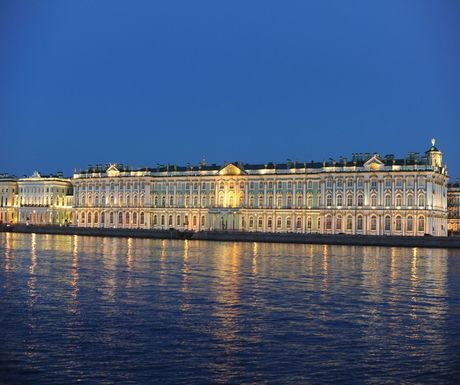 Alexander Palace and Park
Alexander Palace was built to the order of Catherine the Great for her grandson Alexander Pavlovich (later Alexander I), it was designed by Quarenghi in the classical style, and by tradition it was lived in by the Heir Apparent, (Nicholas I, Alexander II and III all lived here before becoming Tsar). Nicholas II and the last imperial family chose to make the Alexander Palace their main home, not the grand Winter Palace in the centre of the city.
In the weeks after the Imperial Family had left, it was already a museum, left exactly as it was on August 14, 1917. There was a huge demand to visit the palace. In 1934 more than half a million Soviet tourists visited the palace. During WWII the Palace was looted by the invading Germans and their Spanish allies (many of the treasures are still in German and Spanish museums), the palace was less damaged than the majority of Imperial palaces. What finished off the Alexander Palace was pilfering, the sale and removal of its contents, state vandalism (Stalin ordered the destruction of many of the rooms in which Nicholas and Alexandra had lived), and ultimately deliberate neglect – for a while it was a holiday home for the NKVD (secret police), part of the palace was still used as offices, by the Baltic Fleet for many years. Today, the palace is closed, and has been for several years. The plan being to restore it to its former glory. It is due to reopen in July 2018, to mark the 100th anniversary of the death of the last imperial family.
Alexander Palace and Park
Alexander Palace was built to the order of Catherine the Great for her grandson Alexander Pavlovich (later Alexander I), it was designed by Quarenghi in the classical style, and by tradition it was lived in by the Heir Apparent, (Nicholas I, Alexander II and III all lived here before becoming Tsar). Nicholas II and the last imperial family chose to make the Alexander Palace their main home, not the grand Winter Palace in the centre of the city.
In the weeks after the Imperial Family had left, it was already a museum, left exactly as it was on August 14, 1917. There was a huge demand to visit the palace. In 1934 more than half a million Soviet tourists visited the palace. During WWII the Palace was looted by the invading Germans and their Spanish allies (many of the treasures are still in German and Spanish museums), the palace was less damaged than the majority of Imperial palaces. What finished off the Alexander Palace was pilfering, the sale and removal of its contents, state vandalism (Stalin ordered the destruction of many of the rooms in which Nicholas and Alexandra had lived), and ultimately deliberate neglect – for a while it was a holiday home for the NKVD (secret police), part of the palace was still used as offices, by the Baltic Fleet for many years. Today, the palace is closed, and has been for several years. The plan being to restore it to its former glory. It is due to reopen in July 2018, to mark the 100th anniversary of the death of the last imperial family.
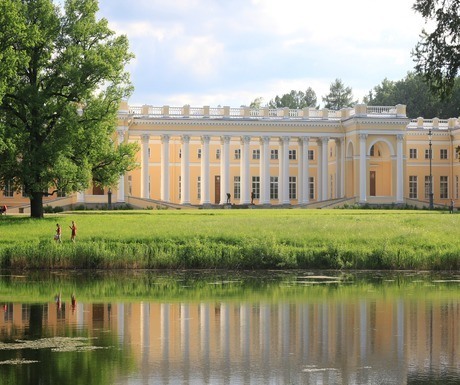 Battleship Aurora
A floating piece of Russian history, the battleship Aurora was constructed in 1897 and served in the Russo-Japanese war, World War I, The October Revolution, and World War II. A blank shot from the canons of Aurora marked the beginning of the October Revolution, and for the last 70 years the ship has been moored in St Petersburg as a museum. In 2014, the Russian Navy had the ship renovated at the cost of $13Million. It returned to its mooring in St Petersburg after two years and has been as popular as ever with Russian and international visitors ever since.
Battleship Aurora
A floating piece of Russian history, the battleship Aurora was constructed in 1897 and served in the Russo-Japanese war, World War I, The October Revolution, and World War II. A blank shot from the canons of Aurora marked the beginning of the October Revolution, and for the last 70 years the ship has been moored in St Petersburg as a museum. In 2014, the Russian Navy had the ship renovated at the cost of $13Million. It returned to its mooring in St Petersburg after two years and has been as popular as ever with Russian and international visitors ever since.
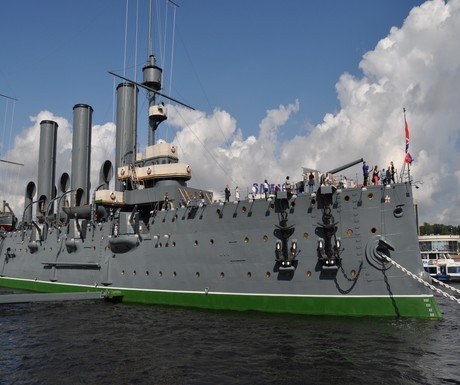 The Tauride Palace
With some disastrous losses at the front in World War I, and political unrest on the streets,Tsar Nicholas II resigned when he lost support of the army. The Tauride Palace became home to the interim provisional government between the February and October Revolutions. Since the end of the Soviet Union, this magnificent palace, commissioned by Grigory Potemkin to impress Catherine the Great, has been used as the home of the Commonwealth of Independent States (CIS) – former Soviet Republics. It was closed to the public for many years. Today constitutional assemblies are still held here, and it is possible to pre-book a private tour, with a minimum of one months’ notice.
The Tauride Palace
With some disastrous losses at the front in World War I, and political unrest on the streets,Tsar Nicholas II resigned when he lost support of the army. The Tauride Palace became home to the interim provisional government between the February and October Revolutions. Since the end of the Soviet Union, this magnificent palace, commissioned by Grigory Potemkin to impress Catherine the Great, has been used as the home of the Commonwealth of Independent States (CIS) – former Soviet Republics. It was closed to the public for many years. Today constitutional assemblies are still held here, and it is possible to pre-book a private tour, with a minimum of one months’ notice.
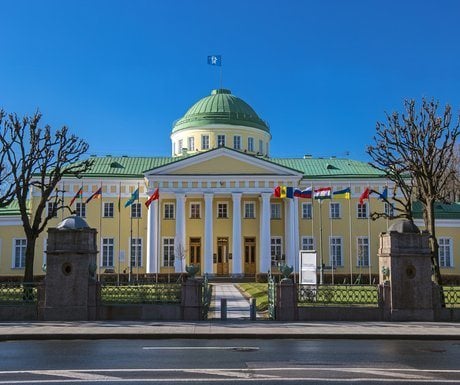 Yusupov Palace
With World War I raging, and Tsar Nicholas away from St Petersburg much of the time, Alexandra, was wielding more and more influence on state affairs. Her close advisor was the monk, Grigory Rasputin. Many thought that the influence of Rasputin had to be stopped, including Prince Yusupov of the very wealthy aristocratic Yusupov family. The Yusupov Palace is worth visiting for many reasons – it’s private theatre, Arabian room and library, but it is most famous as the site of the poisoning and eventual murder of Grigory Rasputin.
Yusupov Palace
With World War I raging, and Tsar Nicholas away from St Petersburg much of the time, Alexandra, was wielding more and more influence on state affairs. Her close advisor was the monk, Grigory Rasputin. Many thought that the influence of Rasputin had to be stopped, including Prince Yusupov of the very wealthy aristocratic Yusupov family. The Yusupov Palace is worth visiting for many reasons – it’s private theatre, Arabian room and library, but it is most famous as the site of the poisoning and eventual murder of Grigory Rasputin.
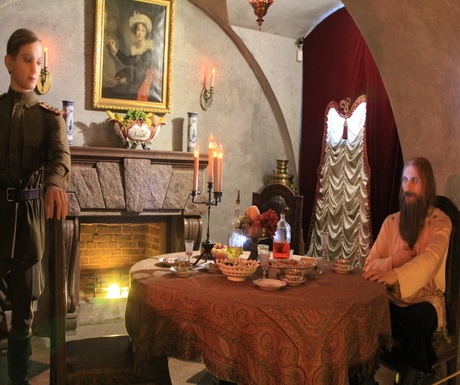 Smolny Institute
The Smolny Institute was formerly a school for girls. The Bolsheviks commandeered the building and made it the headquarters of the government until March 1918 when the capital was moved back to Moscow from St Petersburg. This was the nucleus of Bolshevik activity and rule, and where Lenin proclaimed Soviet power. Today you can book a tour to visit historical parts of the building, including Lenin’s office and the assembly hall.
Smolny Institute
The Smolny Institute was formerly a school for girls. The Bolsheviks commandeered the building and made it the headquarters of the government until March 1918 when the capital was moved back to Moscow from St Petersburg. This was the nucleus of Bolshevik activity and rule, and where Lenin proclaimed Soviet power. Today you can book a tour to visit historical parts of the building, including Lenin’s office and the assembly hall.
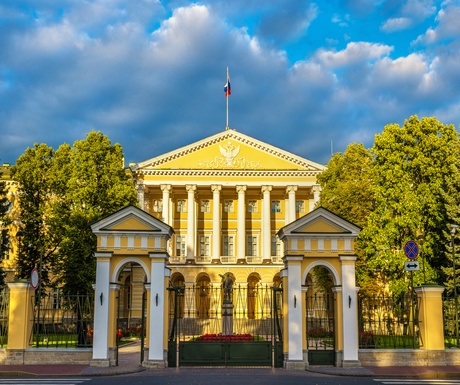 Peter & Paul Cathedral & Prison
The golden spire of the Peter & Paul Cathedral is the symbol of the city of St Petersburg, being one of the original buildings to survive from the founding of the city in 1703. Every single Romanov Tsar is buried here. Now Nicholas, Alexandra and the entire last Imperial family is also buried here, and this is the best place to come with a guide to learn about the entire Romanov dynasty through their family tree. The cathedral is within the Peter & Paul Fortress that ironically also housed a prison used by the imperial family to imprison political prisoners. Later, the Bolsheviks would use the prison for the same purpose.
Peter & Paul Cathedral & Prison
The golden spire of the Peter & Paul Cathedral is the symbol of the city of St Petersburg, being one of the original buildings to survive from the founding of the city in 1703. Every single Romanov Tsar is buried here. Now Nicholas, Alexandra and the entire last Imperial family is also buried here, and this is the best place to come with a guide to learn about the entire Romanov dynasty through their family tree. The cathedral is within the Peter & Paul Fortress that ironically also housed a prison used by the imperial family to imprison political prisoners. Later, the Bolsheviks would use the prison for the same purpose.
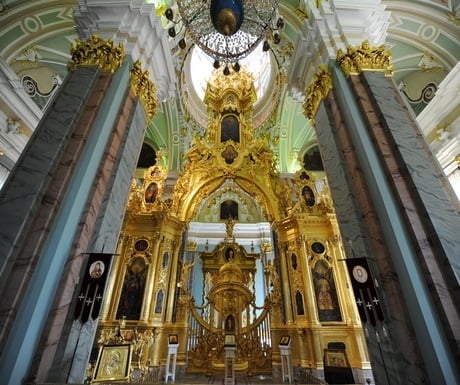 A visit to St Petersburg will bring history that changed the world to life. For a real-time in-depth look at the events leading up to the Revolution, this website is fantastic detailing the series of events that took place 100 years ago, by people that were there.
Ala Osmond is Director at Exeter International.
If you would like to be a guest blogger on A Luxury Travel Blog in order to raise your profile, please contact us.
A visit to St Petersburg will bring history that changed the world to life. For a real-time in-depth look at the events leading up to the Revolution, this website is fantastic detailing the series of events that took place 100 years ago, by people that were there.
Ala Osmond is Director at Exeter International.
If you would like to be a guest blogger on A Luxury Travel Blog in order to raise your profile, please contact us.Did you enjoy this article?
Receive similar content direct to your inbox.


St Petersburg just has so much to offer. I have visited before, but never thought to do something of a “Russian Revolution” tour. As I have a lot of interest in history, this looks like a great way to spend a weekend immersing yourself in the Imperial family.
This was history lesson indeed! I haven’t learned much at all about Russian history, and this post made me realise truly how little I know. I’m not hugely into Politics but I feel as if the musem of political history would be interesting nonetheless. I’d definitely have to visit Alexander Palace and Park – I’m a sucker for old, beautiful architecture and a preened garden!
Thank you! This is a very useful material for tourists. You have listed very important and interesting places in St. Petersburg.
I’ve always wanted to visit St Petersburg! The architecture of all these buildings is incredible. I’d love to visit and learn more about the history and culture of this amazing place. This article is very interesting feel like I’ve learnt a lot from it.